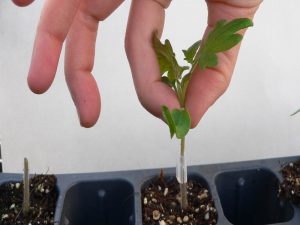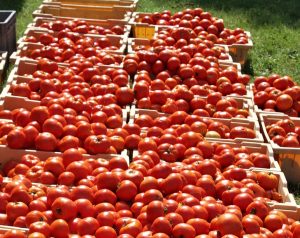Search Results for: grafting manual
Grafting Manual
Introduction to the Vegetable Grafting Manual
Grafted vegetable plants are ‘physical hybrids’ resulting from combining at least two varieties, a rootstock and at least one scion; the first used to provide important traits and the second used to produce fruit. The process is analogous to organ transplantation in that rootstock and scion varieties and seedlings must be compatible, the operating room and patients clean and disease-free, the grafter using appropriate methods, and the newly-grafted plants allowed to recover under specific conditions. This collaboratively developed manual describes major aspects of making grafted vegetable plants, emphasizing research-based information and approaches proven by experience to be reliable. Still, despite much progress in grafting methodology, there are few absolute truths in vegetable grafting and ongoing research and trial and error continue to improve locally-relevant techniques, tools, and knowledge. Therefore, the manual is structured and offered as a “living document” that will be updated as new information and improvements become available. Readers are encouraged to return to this page periodically to check for new manual components.
Continue to the Grafting Manual

Contributors: Chieri Kubota(1),Xin Zhao(3), Carol Miles(2), Matthew D. Kleinhenz(1), Suzette P. Galinato(2), R. Karina Gallardo(2), Erin Rosskopf(4), Cristina Pisani(4),
Francesco Di Gioia(3), Pinki Devi(2), Wenjing Guan(5), Danielle Crow(2),Wuu-Yang Chen(6), Li-Ju Lin(6), and Gregory C. Luther(6)
(1) The Ohio State University, (2) Washington State University, (3) University of Florida, (4) USDA-ARS, Ft. Pierce, FL, (5) Purdue University, (6) World Vegetable Center
Table of Contents
Grafting of vegetable seedlings is a unique horticultural technology that is used worldwide to overcome soil-borne diseases and pests, and/or to increase plant vigor under various environmental stress conditions such as salinity, drought, flooding and low temperature.

Chapter 1. History of Vegetable Grafting
1.1 History of Vegetable Grafting, Synopsis: Grafting is an old and new technology to enhance the sustainability of vegetable crop production. The history of introducing this practice is summarized.
Chapter 2. Principles of Grafting
2.1 Why Graft? Synopsis: Vegetable grafting creates a new plant by combining two plants with different genetic background, with one (scion) providing the shoots and the other the roots (rootstock), combining the desirable traits of both.
2.2 Preparing Seedlings and Rootstocks to Graft, Synopsis: Producing seedlings specifically to prepare grafted plants requires particular attention to procuring space and supplies, timing sowings, disease management, and modulating growth through irrigation, lighting, and temperature regimens.
2.3 GAP and Pathogen Control during Propagation
2.4 Healing and Acclimatization Methods and Design Principles, Synopsis: Healing is the most critical process of vegetable grafting propagation. Close attention to principles of successful healing is needed for good results.
2.5 Transplanting Grafted Plants, Synopsis: After healing, grafted vegetable plants need to be prepared for transplanting to the growing area. This is especially important when planting in open fields. Best practices will vary with conditions.
Chapter 3. Crop Specific Grafting Methods, Rootstocks and Scheduling
3.1 Tomato, Synopsis: Tomato (Solanum lycopersicum) is one of the most important and widely cultivated vegetable crops in the world. Grafting gained popularity as a method to manage soil-borne plant diseases, and to ameliorate certain abiotic stressors affecting tomato.
3.2 Watermelon & Melon, Synopsis: Watermelon grafting became a standard practice to manage disease as early as the 1930s. In addition, grafted plants are also used to manage salinity in soil and irrigation water.
3.3 Eggplant, Synopsis: Grafting eggplant (Solanum melongena) to disease resistant rootstocks is commonly used for disease and abiotic stress management in commercial production. Grafting methods can be adapted to various systems of plant production.
3.4 Pepper, Synopsis: Peppers are annual or perennial vegetable crops in the Solanaceae family, indigenous to Central and South America. Capsicum annuum is the most widely cultivated and economically important species.
Chapter 4. Automation and Controlled Environment Technologies
4.1 Automation in Vegetable Grafting Nurseries, Synopsis: Technologies for nursery automation have been developed to address high labor cost issues in commercial operations. Types of automation in-clude machines to handle most aspects of plant production.
Chapter 5. Designing Logistics/Workflow of Grafting Nurseries
5.1 Designing Logistics/Workflow of Grafting Nurseries, Synopsis: As grafting is primarily an assembly operation, logistics and workflow in the context of labor management are critical considerations for commercial grafting nurseries. These operations need to be optimized to reduce time spent on each step while assuring quality of the end product.
Chapter 6. Cost Analysis
6.1 Cost Analysis for Vegetable Grafting, Synopsis: An overview and some examples of the costs that need to be considered when evaluating the economic feasibility of grafting plants. Regardless of the scale of production, producers face the same major cost categories
Chapter 1. History of Grafting

1.1 History of Vegetable Grafting
Author: Chieri Kubota, The Ohio State University
Other resources
*Nishio, T. (translated by S. Kawai and A. Formiga) 2018. A dim light ignited a century ago: The invention of vegetable grafting by farmers. Oregon Small Farm News. 13:6-8.Chapter 2. Principles of Grafting

2.1 Why Graft?
Authors: Xin Zhao (University of Florida), Carol Miles (Washington State University), and
Chieri Kubota (The Ohio State University)
2.2 Preparing Seedlings & Rootstocks to Graft
Author: Matthew D. Kleinhenz (The Ohio State University)
Other resources
*Young, M.L. and M.D. Kleinhenz. 2010. Seed-to-Grafted-Plant Calculator. The Ohio State University, Vegetable Production Systems Laboratory *Grafting: Galleries, Publications, Recordings, Tools. The Ohio State University, Vegetable Production Systems Laboratory *Ivey-Lewis, M.L. 2015. Bacterial disease management of vegetable transplants. *UMass Amherst. 2015. Vegetable bedding plant production and pestAbout Our Work
Grafting: A Growing Science with Potential and Needs
For growers of fruit-producing vegetable crops, grafted plants are versatile, scaleable solutions to production issues. Grafted plants speed the delivery of new traits to a range of farms, enhancing farm resiliency and profit potential. Grafted plants can also be produced and sold by growers as an added revenue source.
Grafted plant production in the U.S. increased from virtually zero in 2012 to approximately 8 million plants annually for watermelon and tomato in 2020. Despite this growth, U.S. propagators currently supply less than 1% of the estimated demand for grafted vegetable plants. And growers often lack guidance on optimal management practices for grafted plants.
Our team is a coordinated, comprehensive, national research-extension effort to ensure the U.S. vegetable industry prospers from grafting. Our team integrates resources from ten U.S. universities and the USDA Horticultural Research Laboratory in Ft. Pierce, Fla. industry partners to guarantee the timely, direct access to relevant, current, comprehensive, and research-based information for preparing, distributing, and growing grafted vegetable plants.
Vegetable Grafting Team Goals
Rootstock Selection / Genetics
Grafting Best Practices
Domestic Industry Development
…
Reference Database
Research-based technical reference information on vegetable grafting is useful in developing rootstocks and in preparing, using and evaluating grafted plants. Research-based information is published globally in peer-reviewed journal articles, books, proceedings, and technical meeting summaries. Identifying groups of these publications focused on specific topics is time-consuming and challenging but very important, especially to researchers. References in the citation database available at the link below will assist investigators in developing their personal library of research-based vegetable grafting literature.
The database was created early in 2015 at The OSU-OARDC using four search engines: ISI Web of Knowledge, CAB Direct, Agricola and Google Scholar. Search terms included: cucumber, cucurbit, eggplant, graft, melon, pepper, rootstock, solanaceae, squash, tomato, vegetable, and watermelon. The master list of citations developed with these search engines and terms included any of the terms in any field of the citation (e.g., title, keyword, abstract). Individual citations in the database are published in English and include a practical connection to preparing, using or evaluating grafted vegetable plants. This practical connection may be indirect but it must be easily recognizable. Citations based on the use of grafting only as a tool or process to reveal fundamental aspects of plant biochemistry, physiology, etc are not included in the database. Cited publications are journal articles, books, reviews, proceedings and reports from technical meetings.
The database may be viewed online or downloaded. It will be updated often, based on automated reports provided by the search engines and manual searching. Also, relevant citations will be included if nominated so suggestions are encouraged.
The database is available to download here.
Please click here to comment on the database, to suggest a citation for it or to indicate that you are having trouble accessing or using it.
…



